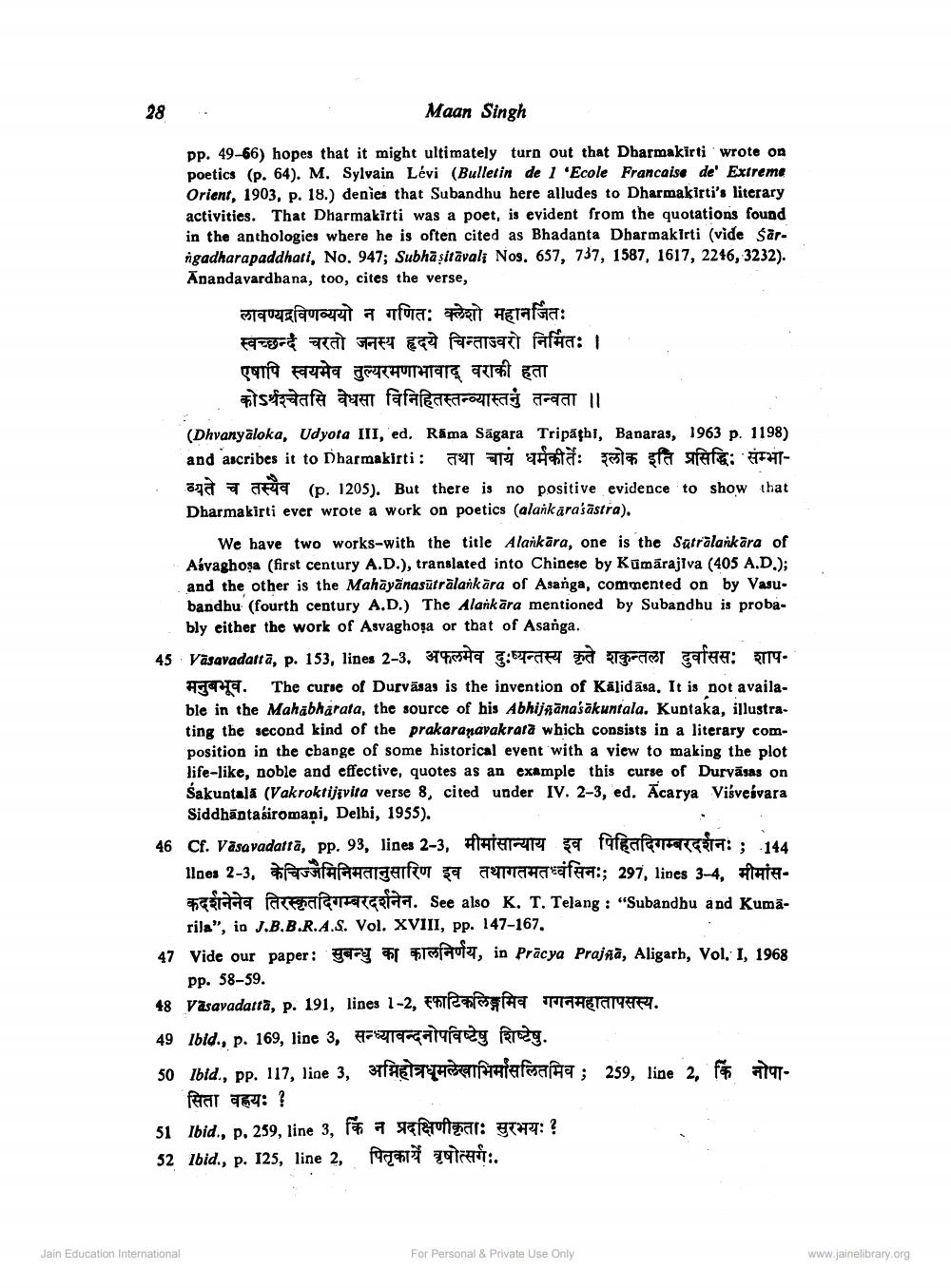________________
Maan Singh
pp. 49-66) hopes that it might ultimately turn out that Dharmakirti wrote on poetics (p. 64). M. Sylvain Lévi (Bulletin de 1 'Ecole Francaise de' Extreme Orient. 1903, P. 18.) denies that Subandhu here alludes to Dharmakirti's literary activities. That Dharmakirti was a poet, is evident from the quotations found in the anthologies where he is often cited as Bhadanta Dharmakirti (vide sarngadharapaddhati, No. 947; Subhā sitävali Nos, 657, 737, 1587, 1617, 2246, 3232). Apandavardhana, too, cites the verse,
लावण्यद्रविणव्ययो न गणित: क्लेशो महानर्जितः स्वच्छन्दै चरतो जनस्य हृदये चिन्ताज्वरो निर्मितः । एषापि स्वयमेव तुल्यरमणाभावाद् वराकी हता
कोऽर्थश्चेतसि वेधसा विनिहितस्तन्व्यास्तनुं तन्वता ।। (Dhvanyaloka, Udyota III, ed. Rama Sāgara Tripāthi, Banaras, 1963 p. 1198) and ascribes it to Dharmakirti: 7 T a t: sta sfera: FSTaga 7 ORTE (p. 1205). But there is no positive evidence to show that Dharmakirti ever wrote a work on poetics (alankarasāstra).
We have two works-with the title Alankāra, one is the Satralankära of Ašvaghosa (first century A.D.), translated into Chinese by Kumārajiva (405 A.D.); and the other is the Mahāyānasütrālankāra of Asanga, commented on by Vasu. bandhu (fourth century A.D.) The Alankāra mentioned by Subandhu is proba
bly either the work of Asvaghosa or that of Asanga. 45 Vasavadattā, p. 153, lines 2-3, 3797547 giore a Te gatea: 3719.
HERE. The curse of Durvāsas is the invention of Kālidāsa. It is not available in the Mahabharata, the source of his Abhijnanasākuntala. Kuptaka, illustrating the second kind of the prakaranavakrata which consists in a literary composition in the change of some historical event with a view to making the plot life-like, noble and effective, quotes as an example this curse of Duryāsas on Śakuntala (Vakroktijivita verse 8, cited under IV. 2-3, ed. Acarya Viśvesvara
Siddhānta siromani, Delhi, 1955). 46 Cf. Väsavadatta, pp. 93, lines 2-3, Hatert fafgafas : : 144 Noes 2-3, parafa Pahalgarftu C JETTAHEFT; 297, lines 3-4, HHIA
ada fasebaluaketa. See also K. T. Telang: "Subandhu and Kumārila", io J.B.B.R.A.S. Vol. XVIII, pp. 147-167, 47 Vide our paper: gary for fresfatuit, in Prācya Prajñā, Aligarh, Vol. I, 1968
pp. 58-59. 48 Väsavadatta, p. 191, lines 1-2, FAT
TITAETATTETRI. 49 Ibid., p. 169, line 3, 77529acatuareg freeg. 50 lbid., pp. 117, line 3, 3AETTET ratefesafna; 259, line 2, fx #91
faat : ? 51 Ibid., p. 259, line 3, PE 77 aleruflar: 973:? 52 lbid., p. 125, line 2, Paai aan:.
Jain Education International
For Personal & Private Use Only
www.jainelibrary.org




